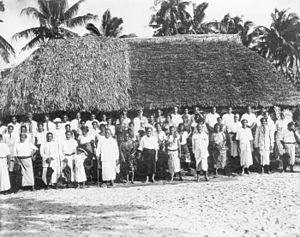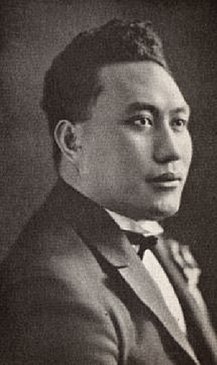Falefa
[1] It was the ancient capital during the ‘Malo’ (‘government’) of Tupu Tafa'ifa (King) Fonoti after defeating his kin Va'afusuaga Toleafoa and Samalaulu for control of Samoa.
[2] Falefa is headed by the descendants of its two founders - Moeono Falealoga (tulafale-alii or 'matua') and Leutele Leutogatui (matua-alii), the sons of Tui Atua Lemua'iteleloloa and his wife, Leateafaiga.
[3] Since the 17th century, this mantle has been occupied mainly by one of the two Tama-a-'āiga (maximal lineage chiefs) of Ātua's Salamasina line: Tupua Tamasese and Matā'afa.
Oral tradition and archaeological evidence from the nearby Sasoa'a Lapita discovery site in the Falefa valley place the date of settlement in the area to 300B.C.
[6] According to oral tradition, Falefa was founded by the two sons of Tui Atua Lemua’iteleloa and Leateafaiga (daughter of Lufasiaitu of Uafato, Fagaloa) - Moe'ono Faleologa & his brother Leutele Leutogitui.
Moe'ono and Leutele bestowed titles on prominent individuals, creating leading Ali’i (sacred chief) titles Alai’asā, Lealaisalanoa and others who in turn, established 'vassal' houses of their own (called ‘Matai tautua’) to advise on governance matters, to serve in war and to assist with the upkeep of the great houses in times of peace.
Other villages were founded and remain under the leadership of Falefa and are known collectively as the “Falefitu”: Sauano and Saletele in the Fagaloa Bay, Falevao and Lalomauga.
Fale and his brother Puna traveled from Manono to visit their kin, King Fonoti, seeking food for their blind and gravely ill father.
Upon their return to Manono after meeting King Fonoti, they were met with devastating news: their father had already distributed all his matupalapala (land and titles) and mavaega (inheritance) to others.
She established her village and named it Fale ma Puna, later shortened to Faleapuna, in honor of the two brothers from Manono who had served her with dedication.
Puna was bestowed the title Molio’o, with responsibilities that included delivering messages (molimolio’o feau) or conveying Sina’s wishes to her brothers or elsewhere as needed.
[8] These villages maintain historical ties to Falefa, reflecting centuries of intricate political alliances, inter-marriages and shared heritage.
The following morning, Salamasina and Levalasi departed in a large double canoe (alia) and arrived in Saluafata harbor by the afternoon.
Ulualofaiga, the brother of Tui Tonga Faaulufanua and married to a Samoan woman from the Leota family, had lived in Lona for years.
Upon further inquiry, she learned that six large Tongan war canoes had been anchored in Lona for weeks, causing dissatisfaction among the villagers due to the strain on resources.
The sudden arrival of Samoan war canoes and warriors from the mountains surrounded the Tongan forces, thwarting their plot to abduct the Queen.
Leutele, the leader of the Falefa fleet, offered to execute Ulualo, but Salamasina spared his life, cautioning him against future betrayals.
Grateful for her clemency, Ulualo confessed the plot orchestrated by Leifi and Tautolo to abduct Salamasina and install their own candidate as Tui Atua.
[11] For contending with the Manono, Sapapali'i and Saleaumua naval forces and securing his victory at sea, the leaders of Faleapuna and Fagaloa were granted a district of their own called Vaa-o-Fonoti ('Fonoti's War Fleet').
[5] Upon the death of a Moe'ono or Leutele, the district goes into an extended period of mourning and kicks off the procession of cultural protocol and rituals that follows.
At the appointed time when an heir has been chosen, the proceedings of the saofa'i (bestowment ceremony) stipulate that only the two bearers of the titles of the two brothers - Moe'ono and Leutele - are part of this sacred ritual.
This was also the first saofa’i of a Leutele without an incumbent Moe'ono (and vice versa) to participate in the ancient ritual where the descendant of one brother presided over the ascension of the other.
Atua and A'ana forces gave chase and as they arrived at Ana, prepared to complete their victory by burning the entire region and killing off the rest of Malietoa's troops.
Pulemagafa, too, must have heard the story of Iuli's plea, and old and blind as he was, he made his way forward to the mouth of the cave guided by his son Falefataali'i.
Pulemagafa's earnest appeal was poorly received, for great was the rancour between the warring districts, until he announced that Malietoa was willing to pay as ransom (togiola, which literally means, ‘the price of one's life') the island of Tutuila.
Such an offer was eagerly grasped, and before long the great sailing canoes of Atua were heading eastward to claim the prize, while Malietoa and his crest-fallen followers returned to their villages.
Choosing to arrive at Satupa'itea instead of Sale'aula, Moe'ono recalled Falefa's earlier support for the Mau a Pule [19] (which Savaii's orators had led during the German administration, a precursor to the Mau Movement) and called on Asiata to have Pule (Savaii's orator polity and counterpart to Upolu's Tumua) reciprocate their solidarity by joining forces with them in order to nationalise the cause for independence.
However, these amicable relations were eventually fractured in 1965 when a major split appeared over the successor to Samoa's former co-Head of State Tupua Tamasese Mea'ole, who died two years earlier.
Despite the stalemate, Tupuola Efi pressed his claim and proceeded without the unanimous support of Āiga Sā Fenunuivao and most notably, that of Moeono Alai'asā Kolio Luafalemana and the Lufilufi polity.
On the morning of his installation ceremony at Vaimoso, the nation's public broadcaster, Radio 2AP, read an announcement from Moeono, notifying the country that 'Āiga Sā Fenunuivao as well as the chiefs of Lufilufi had not sanctioned Tupuola Efi's ascension to the title and would not allow for the ceremony to proceed at the title's appurtenant maota at Mulinu'ū ma Sepolata'emo in Lufilufi.







